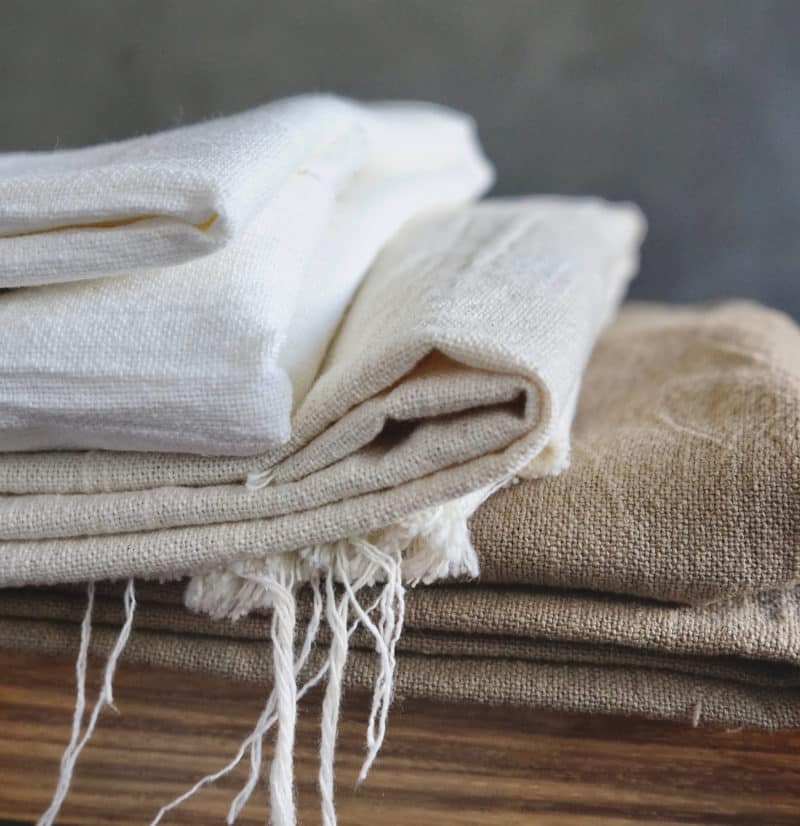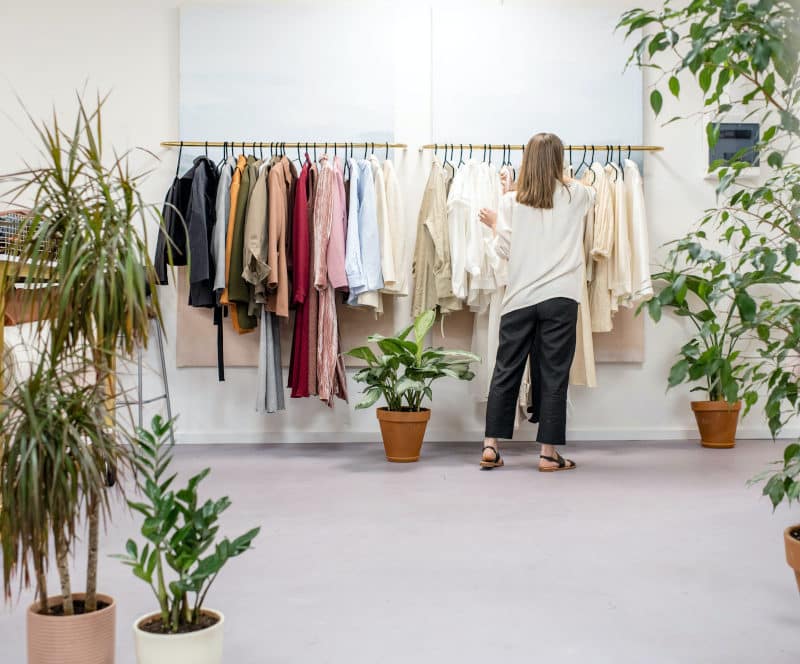Hemp Fabric – Is It Really That Sustainable?
Hemp fabric is being dubbed the latest environmentally-friendly material on the market. With fast fashion brands coming under fire for their use of plastic-based materials, consumers are demanding natural alternatives that do not harm the Earth. Hemp is said to be an incredibly versatile, strong, and sustainable crop.
Where people used to associate hemp solely with hippies, it has become increasingly popular in clothing brands today. Hemp has redeemed its image in recent years, and it definitely has a huge amount of potential.
Its fabric profile and environmental status mean it can feature in clothing that looks great and feels good. But is hemp really that sustainable? Let’s dive into this further below.
What Is Hemp Fabric?
Hemp fabric is a textile that consists of fibres from a high-yielding crop in the cannabis sativa plant family. That’s right, hemp is derived from the stems of the cannabis plant. Although hemp comes from this plant, it is processed in a certain way to ensure potency levels are kept very low.
In other words, there is no way you can get high from hemp. The material has been used for a range of industrial purposes historically. For example, for sails and ropes.
It has been cultivated for thousands of years and is known across the globe. Hemp dominated fibre crops in the 16th and 18th centuries in Europe, North America, and Asia.

Hemp fabric is renowned for being one of the most durable and versatile natural fibres. It is thought to have eight times the strength of other natural fibres.
This makes hemp fabric an excellent option for daily use. On its own, hemp fabric can be rough to the touch. However, when it is woven into the material, it can be just as soft as cotton.
When hemp fabric is processed, it is highly resistant to forming small balls of fluff or pilling. Additionally, it is lightweight, breathable, and enables the passage of moisture from the skin to the atmosphere.
This means hemp fabric keeps you cool in both warm and cold weather. Likewise, the material is also highly resistant to harmful microbes, mildew, and mould.
How Is Hemp Fabric Made?
Hemp fabric is created from the long strands of fibre that make up the stalk of the cannabis plant. These fibres are separated from the bark. This is done via a process known as retting.
It entails using moisture and microbial activity on plants to dissolve or rot away a large portion of the pectins and cellular structures encasing bast-fibre bundles. This makes it possible to separate the plant’s fibre from its stem.
During the retting stage of hemp, the stems are placed on the ground for numerous weeks. The pectin, which binds the hemp fibre, begins to slowly decompose. From then, the fibre is separated from the bark.
After the retting stage of hemp, the lignin is removed. Lignin is an organic polymer. It is responsible for making plants woody. In order words, it is what makes hemp feel rough and scratchy. To make the hemp fabric more skin-friendly and soft, the lignin has to be removed.
Once the lignin has been removed, the hemp fibres are spun and twisted together to create long threads. These long threads are then woven into the textile. The threads are very similar in texture to linen.
At this point, the hemp long threads can be blended with various other natural fibres. For instance, cotton or bamboo creates the perfect balance between strength durability and softness.
The processing methods used to create hemp fabric were developed originally in the early 1900s. They are only now being updated to meet the rising demand for the material.
The numerous stages within the process can be carried out organically via a mechanical process. This process requires no chemicals. In saying that, a lot of companies are still adding chemicals into the process of creating hemp.
This chemical-intensive process is a lot more intense on the planet. However, it makes hemp cheaper and faster to create, which is why it is so appealing.
Generally, you can find out if a hemp product was created this way by looking at the label. If it reads ‘hemp viscose’ you can presume it was made using a harmful processing method that involves the harsh chemicals that are used to create viscose.
Is Hemp Fabric Sustainable?
As a natural plant fibre, hemp is one of the most sustainable options. It requires very little water to grow. Moreover, it replenishes soil nutrients to help enhance soil health. If that wasn’t enough, hemp is also one of the stronger textile fabrics.
It is biodegradable and offers anti-radiation, insulating, and anti-bacterial properties too. You won’t find a more sustainable plant to grow than hemp, but what about when it is woven into fabric?

As mentioned above, the numerous stages of the process of turning hemp into a fabric can be carried out organically using zero chemicals.
In saying that, businesses do produce hemp using chemicals more often because it is both cheaper and faster. With this in mind, the process is quite intense on the planet.
In addition to that, the process can also include harmful dyes, which can cause other environmental outcomes, depending on the techniques employed. Another thing to keep in mind is the cost of production.
Hemp is rather heavy, so transporting it can be energy-intensive and expensive. The solution to getting around this is localised supply chains.
In essence, the production stage of hemp is not always environmentally sound. With the crop itself being so sustainable, producers have a responsibility to make sure their manufacturing processes take the planet, their workers, and customers into account, as well as profitability.
Hemp is more sustainable than most fabrics, and it is a low-impact crop. The issues surrounding its sustainability status become relevant during the production process. Beyond its environmental status, it is also a high-quality fabric.
Advantages and Disadvantages of Hemp Fabric
Now that you understand a bit more about hemp fabric and its sustainability status, let’s look at its advantages and disadvantages. Whilst hemp fabric’s characteristics are largely positive, it does have some disadvantages.
Disadvantages
Below are some of the disadvantages of the hemp fabric.
Hemp requires a bit more care than other fabrics
The first disadvantage of hemp fabric is that it requires a bit more care than other fabrics. In other words, it can shed after initial wear, and sometimes it cannot be thrown into the washer or dryer.
Oftentimes, it is best to wash hemp fabric on cold without any chemicals and follow with air-drying to prevent shrinkage and wrinkles. Although it requires a bit of a different care routine, it will quickly become second nature and simple to do. There is one advantage to this in that air-drying is a lot better for the planet and helps to save energy.
It usually does not come in vibrant colours
Another disadvantage of hemp fabric, particularly if you are quite bold in your fashion sense, is that it doesn’t come in vibrant colours.
This is because it usually does not undergo chemical processes and dying to produce these colours. It is also vital to note here that hemp is not colourfast. With this in mind, coloured hemp items should be washed separately.
Hemp wrinkles easily
Another disadvantage of the hemp fabric is that it tends to crease or wrinkle. It is very similar to linen in that respect. Many complain about it wrinkling and about the texture of the fabric feeling scratchy. In saying that, both of these issues can be easily overcome.
For example, purchasing a hemp blend fabric can ensure the texture is soft. This blend could be organic cotton and hemp, for instance. Additionally, you can tackle wrinkles by ironing and hanging these clothing pieces overnight.
It is more expensive
Hemp is also a lot more expensive than other commonly used fabrics like linen, nylon, and cotton. The reason for this is due to the lag in production. While it is an easy crop to yield, we are still very much stuck in our ways.
We have been producing materials like cotton for years, and transitioning to hemp production has been a major learning curve. However, producing hemp fabric is becoming increasingly common, so the prices are sure to continue to decrease. Soon, hemp processing will increase and will be more competitively priced.
Advantages
Now that we have delved into the disadvantages of hemp, let’s look at its many positives.
No insecticides or herbicides are required to grow hemp
One of the greatest advantages of hemp fabric is that no herbicides or insecticides are required to grow the crop. Hemp is naturally resistant to numerous insect species. Additionally, hemp plants can tackle weeds on their own. This means herbicides are not needed to control weeds. This is a major plus since research has found herbicides to pose serious health risks to humans, animals, and the planet.
Hemp purifies the soil and prevents erosion
Some other great benefits of this crop are that it purifies the soil and prevents erosion. Hemp plants do not require chemicals to grow. Due to this, they can help purify the soil.
It can also regenerate soil that has been polluted by harsh heavy metals. Not to mention, the crop can grow in a wide variety of soil types. What this ultimately means is it can reclaim the land where other crops can not flourish.
The hemp crops also help in preventing the erosion of topsoil. This is thanks to their long roots, which bind the soil together. Due to this, hemp crops play a significant role in preventing infertile land and clogged waterways.
Some crops, for instance, cotton, can increase soil erosion, so it is fantastic news that hemp does the opposite.
Saves water and is carbon-negative
Hemp requires very little water to flourish. To put that into perspective, it needs around half the amount cotton plants need. What this means is very little water is actually wasted when producing hemp.
The crop is also considered to be carbon-negative because it can absorb much more CO2 than trees. Hemp also grows quicker than trees and more densely. As soon as it is planted, it begins to absorb these gases which means it helps to fight climate change throughout its entire growth cycle.
Hemp is durable, high-quality, and blendable
The hemp fabric is also incredibly durable and strong. It offers wearers the ultimate comfort and protection. The material is breathable and gets softer after every wash. It is also weather-resistant and has a very high thread count.

Hemp’s strong fibre profile also means it can be easily blended with other materials to make it even more luxurious. For instance, organic cotton.
It leaves behind very little waste and is biodegradable
Finally, hemp leaves behind very little waste and is biodegradable. Every single part of the crop can be used. The roots can be used for organic compost and medicine.
Meanwhile, the seeds can be used for food, supplements, health and beauty products, and more. The stalks are great for building materials, textiles, and paper.
The flowers and leaves prove useful for mulch and animal bedding. Unlike synthetic fabrics, hemp is also biodegradable and will return to the ground once it is discarded.
Hemp Fabric vs Cotton
Cotton might be more affordable and softer than hemp. However, hemp fabric is four times stronger and is a better quality sustainable fabric overall. Plus, when it comes down to hemp fabric vs cotton, it is vital to consider hemp’s many environmental benefits.
Cotton requires a significant amount of water to grow, whereas hemp uses half the amount and grows much more quickly. Not to mention, the crop actually helps in fighting climate change.
Hemp Fabric vs Modal
Modal is a man-made fibre similar to viscose rayon. It is not inherently environmentally friendly. It is high-quality, natural, lightweight, soft, and flexible. While it starts naturally and is relatively sustainable, the process does involve the use of chemicals, which can negatively affect the planet. Hemp, by contrast, is totally organic and biodegradable. Moreover, the fabric’s profile has most of the characteristics modal offers.
Hemp Fabric vs Rayon
Modal is a type of rayon. Rayon is a semi-synthetic fibre, created from natural sources of regenerated cellulose. It is more sustainable than other entirely synthetic fabrics like nylon and polyester. However, it is not as eco-friendly as entirely natural materials.
The production of rayon fabric can harm the planet, the people working to make it, and animals. Once again, its characteristics are very similar to that of hemp. The main difference between hemp fabric vs rayon is that hemp does not negatively impact the planet.
Key Takeaways of Hemp Fabric
Hemp is an incredibly versatile crop that positively affects the planet throughout its entire growth cycle. Hemp fabric is one of the strongest and most sustainable materials on the market. The only downside is the price, but this is sure to reduce as production increases. While there has been suspicion about how environmentally friendly hemp fabric is, we can confirm it really is that sustainable.